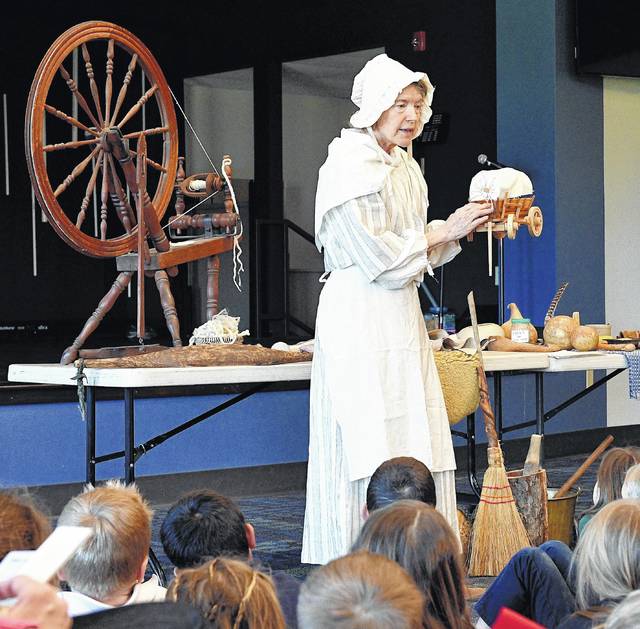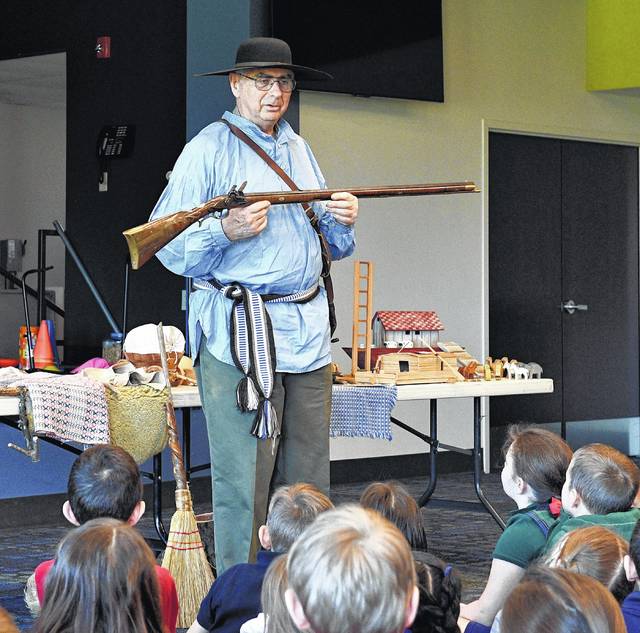

Karen Meyer is a local author of living history books published by Arizona-based Sable Creek Press, but when Meyer makes presentations to elementary-age students at local schools, she’s known as The Pioneer Lady.
Meyer was at Genoa Christian Academy last week speaking to elementary students about pioneer life in Ohio in the 1780s and 1790s, when the area was wilderness before Ohio became a state in 1803.
Dressed as a pioneer, Meyer described a Virginia family that were tenant farmers who decided to travel west in hopes of establishing a farm of their own.
“Many early pioneers, when they lived back east, had to pay for the privilege of farming,” Meyer told the students. “Then they heard about the new fertile land opening up along the Ohio River. All they had to do to claim land for free was go there, use an ax to put a hatchet mark on a tree at four corners of a piece of property, and it was theirs.”
Meyer, basing her tale on a real-life pioneer family, told of traveling to Fort Pitt where in 1780, they had to purchase supplies before embarking on a dangerous flatboat river trip.
“Whatever we would have on the frontier we would have to bring with us,” Meyer said. “At Fort Pitt we had to buy tools, cooking kettles, and corn meal.”
When the family’s flatboat reached an area where the Ohio River was a dividing line between Indian Territory and an area in Kentucky where free land could be claimed, the boat was disassembled and the lumber used to build a basic one-room shelter.
“We were in Limestone, Kentucky, where there were four cabins and a man named Simon Kenton,” Meyer said. “It was a dangerous area populated by Shawnee Indians, and there were bears and other wild animals.”
Meyer said in addition to whatever food pioneers brought to the 1780s wilderness, they had to supplement with roots, berries, nuts, and wild game. Wild game included bear, deer, small animals, and in the early eastern wilderness there were even herds of buffalo.
Meyer’s husband Bob, also dressed as a pioneer, showed the students an actual flintlock rifle that he said was the most important tool that pioneers took with them when entering the wilderness.
In time, Meyer’s pioneer family cleared land and planted gardens, raising squash, beans, and corn. They made clothing from deer hides, and, if they managed to bring sheep, pigs, and cattle to the wilderness they had an additional source of food, as well as hides and wool for spinning and weaving.
“These pioneers had a lot of hardships that we don’t have today,” Meyer said. “And their young ones were very important back then.”
In addition to in school visits, Meyer holds workshops for children that include hands-on activities like soap making, bread making, and leather-work.
“I really enjoy getting children interested in history,” Meyer said. “If you get them hooked on history early, it carries on through the rest of their lives.”
Meyer said she got hooked on history as a young girl. After earning a bachelor’s degree cum laude in English and Education, she became an Air Force wife, and over the course of nine years lived in places as far away as Labrador.
Meyer said seeing new lands gave her a window on regional and national differences that developed into an appreciation for her own Ohio roots where she and her husband settled and raised their family.
For additional information about The Pioneer Lady, to schedule a presentation, and links to order Karen Meyer’s books, including her latest volume about the Underground Railroad, North to Freedom, log on to ohiofrontierhistorylady.com.
Karen Meyer is currently writing a biography of famous pioneer Simon Kenton.



